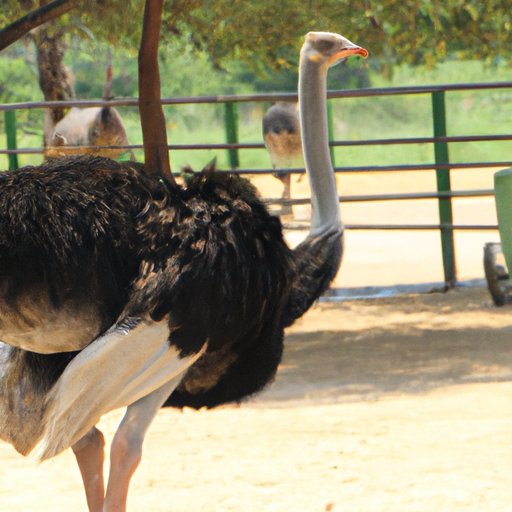Introduction
When you think of birds, you might picture smaller animals, such as sparrows or hummingbirds. But what about the biggest bird in the world? It’s an impressive creature that’s worth learning more about! In this article, we’ll explore the biggest bird in the world and its unique characteristics, habitats, adaptations, and conservation efforts.

A Profile of the Biggest Bird in the World
The biggest bird in the world is the ostrich, which is part of the Struthionidae family. Ostriches are native to Africa and can be found living in the savannah and desert regions. They are the largest extant species of bird in the world. Male ostriches weigh up to 150 kg (330 lbs) and stand at around 2.7 m (9 ft) tall. Females are slightly smaller, weighing up to 100 kg (220 lbs) and standing at around 2.1 m (7 ft).
Ostriches are omnivorous and feed on a variety of plants and small animals. They use their strong legs to kick predators and can run up to 70 km/h (43 mph). When threatened, they will also fluff their feathers and hiss to ward off potential danger. They live and travel in small groups called “herds” and can form pair bonds with other ostriches.

Comparison of the Biggest Bird Species
The ostrich isn’t the only large bird species in the world. Other contenders for the biggest bird in the world include the emu, cassowary, and Andean condor. However, the ostrich is the tallest, heaviest, and fastest of all these species. The emu, which is native to Australia, is the second-largest species of bird and can reach up to 1.9 m (6.2 ft) tall and weigh up to 90 kg (200 lbs). The cassowary is a flightless bird native to New Guinea and Australia that can reach up to 1.5 m (4.9 ft) tall and weigh up to 85 kg (187 lbs). Finally, the Andean condor is a large vulture native to South America that can reach up to 3 m (9.8 ft) in wingspan and weigh up to 15 kg (33 lbs).

Exploring the Habits and Behaviors of the Largest Bird
Ostriches have interesting social interactions and behaviors. They communicate with each other through a variety of vocalizations, including honking and hissing. They often engage in courtship rituals and use their long necks to perform courtship displays. Males are typically territorial and will aggressively defend their mates and territory.
Ostriches migrate seasonally in order to find food and water sources. They tend to nest in open areas, such as grasslands or deserts, where there is plenty of space to move around. During breeding season, females will lay up to 20 eggs in a single clutch. Both males and females take turns incubating the eggs, which can take up to 42 days to hatch.
An Overview of the Biggest Bird’s Natural Environment
Ostriches prefer to live in open habitats, such as savannahs, grasslands, and deserts. They can survive in a wide range of climates, from hot and dry to cool and wet. Their geographical range extends throughout sub-Saharan Africa and into parts of the Middle East. They can also be found in captivity in some parts of the world.
An Examination of the Biggest Bird’s Adaptations
Ostriches have a number of physical and behavioral adaptations that help them survive in their natural environment. Physically, they have long legs and powerful feet that allow them to run quickly and kick predators. They have keen eyesight and hearing that helps them detect potential threats. Behaviorally, they have excellent communication skills and can flock together to protect one another from predators.
The Fascinating History of the Biggest Bird
Ostriches have been around for millions of years and have a rich history. They were depicted in ancient Egyptian art and were hunted for their feathers during the Victorian era. In many cultures, they are symbols of power and strength. Today, they are kept as pets and used in racing events.
How the Biggest Bird Survives in a Changing World
Despite their size and strength, ostriches face various threats in the modern world. Habitat destruction and hunting are the biggest threats to their survival. Conservation efforts are underway to protect their habitats and ensure their long-term survival. Additionally, captive breeding programs are being used to help increase the population of wild ostriches.
Conclusion
The ostrich is an amazing animal and deserves admiration for its size, speed, and intelligence. Although it faces various threats in the modern world, there are conservation efforts underway to protect this species. Knowing more about the biggest bird in the world can help us appreciate its unique qualities and learn how to better protect it.


